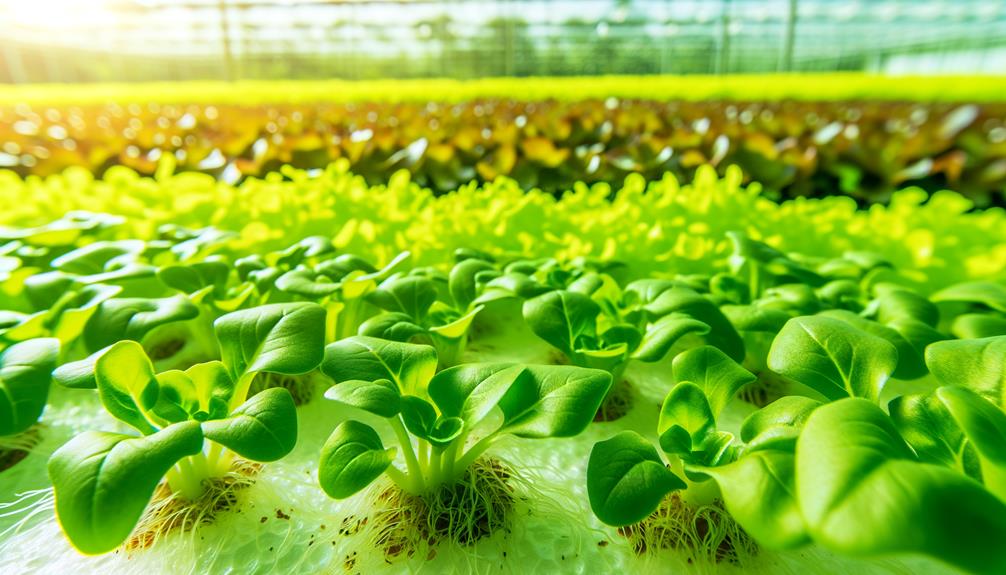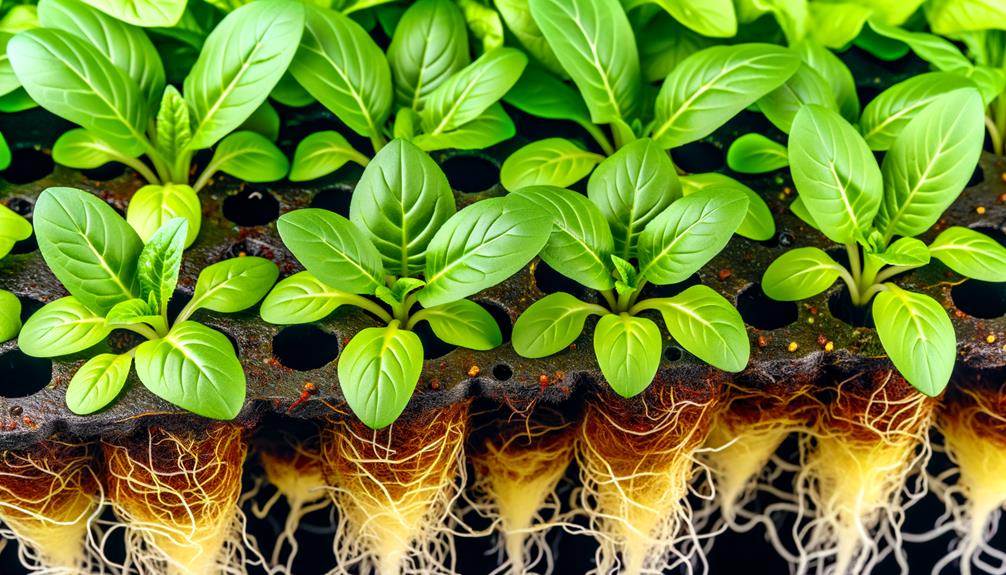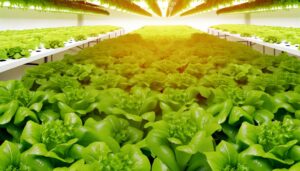When to Transplant Hydroponic Seedlings
We should transplant hydroponic seedlings when they exhibit 2-3 true leaves, a root length of 2-3 inches, and a robust stem at least 2-3 millimeters in diameter. Assess root health by ensuring they are dense and white without discoloration.
Ideal environmental conditions include maintaining a temperature of 70-75°F and humidity levels between 50-70%. Best nutrient uptake requires a pH between 5.5-6.5.
Employing these indicators and environmental parameters will minimize transplant shock and support vigorous growth. For further detail on ensuring ideal growth conditions, we can explore additional facets like system choices and post-transplant care.

Key Takeaways
- Transplant when seedlings have 2-3 true leaves and sturdy stems to reduce transplant shock.
- Ensure roots are 2-3 inches long, dense, and white or light tan in color.
- Seedlings should have at least 2-3 true leaves, each 2-3 inches long.
- Stems should be robust and firm, with a diameter of at least 2-3 millimeters.
Recognizing Seedling Growth Stages

We can accurately determine when to transplant hydroponic seedlings by closely monitoring their growth stages, particularly the development of true leaves and root systems.
Initially, seedlings exhibit cotyledons, or seed leaves, which aren't true leaves and serve as nutrient sources. True leaves emerge thereafter, characterized by their more complex structure and capability for photosynthesis.
We should count the number of true leaves; typically, the presence of two to three true leaves indicates readiness for transplantation. Additionally, we must assess stem thickness, as sturdier stems are less prone to transplant shock.
Ideal Root Development
We should observe root length indicators, ensuring roots are long enough to reach nutrient solutions in the new environment.
Additionally, we need to assess root color, with healthy roots appearing white or light tan, indicating ideal health.
Root density assessment is essential; dense, fibrous root systems suggest robust growth, making the seedlings ready for transplantation.
Root Length Indicators
Ideal root development can be identified when seedlings exhibit roots that are approximately 2-3 inches long and display a healthy white coloration. Observing root length is essential for determining the ideal transplanting time. Roots at this stage are sufficiently developed to support nutrient uptake without being overly entangled, which can impede growth.
| Root Length (inches) | Transplant Readiness |
|---|---|
| < 1 | Not Ready |
| 1 – 2 | Nearing Readiness |
| 2 – 3 | Best for Transplant |
| > 3 | Potentially Overgrown |
We must guarantee precise measurements and vigilant monitoring. By adhering to these root length indicators, we enhance the seedlings' progression to their next growth phase, guaranteeing robust plant development and maximizing yield potential.
Root Color Observation
Healthy root color serves as a critical indicator of ideal root development, often characterized by a vibrant white hue that signifies proper nutrient absorption and overall root health.
When we inspect our hydroponic seedlings, we should look for roots that are free from discoloration, such as brown or black spots, which can indicate disease or nutrient deficiencies.
Evidence suggests that white roots are actively engaging in nutrient uptake and oxygen exchange, both essential for robust plant growth.
Our observations should be frequent and meticulous, ensuring the root environment remains optimal.
Root Density Assessment
Alongside root color, examining root density provides valuable insights into the perfect timing for transplanting hydroponic seedlings. By evaluating the density, we can determine if the root system is robust enough to support nutrient uptake post-transplant. A dense, fibrous root network signifies ideal root development. Conversely, sparse or overly compact roots can indicate insufficient growth or potential issues.
| Root Density Level | Characteristics | Transplant Readiness |
|---|---|---|
| High | Dense, fibrous, white roots | Ideal |
| Medium | Moderately dense, some yellowing | Monitor closely |
| Low | Sparse, thin, discolored roots | Not ready |
High root density correlates with increased nutrient absorption, essential for plant health. Monitoring these parameters guarantees our seedlings shift smoothly to their new environment, maximizing growth potential and yield.
Leaf Count and Size

We focus on leaf count and size as key indicators for transplant timing.
Seedlings should typically have at least two true leaves, and we can measure leaf size to guarantee they're within ideal growth parameters.
These early growth indicators help us determine the seedlings' readiness for a successful changeover.
Optimal Leaf Number
Determining the ideal leaf number for transplanting hydroponic seedlings hinges on evaluating both the leaf count and their overall size.
Typically, seedlings should have 2-3 true leaves, beyond the initial cotyledons, before transplantation. This leaf stage indicates robust photosynthetic activity and root development, crucial for successful establishment in a hydroponic system.
Empirical studies suggest that seedlings with 4-5 cm leaves exhibit better acclimatization post-transplant. Uniform leaf size and number serve as reliable indicators of seedling vigor, minimizing transplant shock.
Let's not overlook that leaf count correlates with nutrient uptake efficiency, which is paramount for hydroponic growth.
Fundamentally, an ideal leaf number guarantees we're fostering resilient plants primed for rapid, sustainable growth in their new environment.
Measuring Leaf Size
Accurately measuring leaf size and count is essential for evaluating the readiness of hydroponic seedlings for transplantation. We utilize calipers to determine leaf length and width precisely, guaranteeing we capture consistent data.
Our target is typically 2-4 true leaves, each reaching at least 2-3 inches in length, which indicates robust vegetative growth. By counting and measuring leaves, we can predict the seedlings' ability to thrive post-transplant.
Research shows that seedlings with these dimensions exhibit superior root development and nutrient uptake. We also recommend documenting leaf area index (LAI) to quantify canopy density.
This evidence-based approach allows us to guarantee prime plant health and maximize yield potential in our innovative hydroponic systems.
Early Growth Indicators
Observing the early growth indicators, such as leaf count and size, allows us to gauge the ideal timing for transplanting hydroponic seedlings.
Typically, seedlings exhibit prime readiness when they've developed two to three sets of true leaves. These leaves, distinct from the initial cotyledons, signify robust vegetative growth.
Measuring leaf size provides further precision; leaves should span approximately 1-1.5 inches in length. This metric guarantees the plant has a well-established root system capable of adapting to a new environment.
Utilizing these indicators, we can minimize transplant shock and enhance growth trajectories.
Stem Strength Indicators
A robust stem is a key indicator that hydroponic seedlings are ready for transplantation. We should examine stem diameter and rigidity, as these factors correlate with the plant's ability to support itself in a new environment.
Research shows that stems with a thickness of at least 2-3 millimeters exhibit enhanced stability and nutrient flow. Additionally, a firm stem that resists bending under slight pressure indicates adequate lignification, which is essential for structural integrity.
Monitoring these parameters helps us guarantee that the seedlings have developed sufficient vascular tissues. Employing precise measurement tools like calipers can improve accuracy in evaluating stem strength.
Environmental Conditions

Having assessed stem strength, we must now consider the environmental conditions that will support successful transplantation.
Ideal temperature ranges between 70-75°F to guarantee robust root development.
Humidity levels should remain consistent, ideally between 50-70%, to prevent plant stress.
Light intensity is essential; we recommend using full-spectrum LED lights, maintaining a 16-hour light cycle for photosynthetic efficiency.
Proper ventilation enhances oxygen availability, vital for root respiration.
Nutrient solutions must be at pH 5.5-6.5 to maximize nutrient uptake.
Consistent monitoring of electrical conductivity (EC) secures balanced nutrient delivery, with ideal EC levels between 1.2-2.0 mS/cm.
Choosing the Right System
Selecting the ideal hydroponic system is essential to guarantee efficient nutrient delivery and robust plant growth. We must evaluate several factors, including the plant type, growth stage, and available space.
Deep Water Culture (DWC) systems excel for leafy greens due to constant nutrient exposure, while Ebb and Flow systems offer flexibility for various crops by periodically flooding the root zone.
Nutrient Film Technique (NFT) is advantageous for plants with smaller root systems, providing continuous nutrient flow. For larger plants, Aeroponics delivers nutrients through mist, maximizing oxygenation and growth rates.
By matching our seedlings to the appropriate system, we guarantee they receive precise nutrient delivery, fostering innovation and maximizing yields.
Let's choose wisely to enhance our hydroponic endeavors.
Preparing the New Medium

To prepare the new medium, we must sterilize it thoroughly to eliminate any pathogens that could hinder seedling development. Sterilization methods vary, but we recommend using a diluted hydrogen peroxide solution. After sterilization, confirm the medium's pH is balanced, ideally between 5.5 and 6.5. This optimization is essential for nutrient uptake.
Here's a quick comparison of common hydroponic mediums:
| Medium | pH Stability | Water Retention |
|---|---|---|
| Rockwool | High | Excellent |
| Coconut Coir | Moderate | Good |
| Perlite | Low | Poor |
| Vermiculite | Moderate | Good |
| Clay Pellets | High | Moderate |
Transplanting Techniques
When transplanting hydroponic seedlings, we must carefully handle the root systems to avoid damage and guarantee successful adaptation to the new medium.
First, we gently lift the seedlings from the initial grow medium, ensuring minimal disruption to the root structure. Using sterile tools, we trim any damaged roots to prevent disease.
Next, we position the seedlings into pre-prepared slots or net pots in the new medium, ensuring roots are adequately spread for ideal nutrient uptake.
It's essential to maintain consistent humidity and temperature during this process to reduce transplant shock. We can use anti-transpirant sprays to mitigate water loss.
Post-Transplant Care

After transplanting, we must closely monitor the seedlings to guarantee ideal growth conditions and swiftly address any signs of stress.
Maintaining optimal nutrient solutions is essential; adjust pH levels between 5.5 and 6.5 and make certain electrical conductivity (EC) stays within recommended ranges. Adequate light intensity, around 14-16 hours daily, will promote robust photosynthesis. Watch for any nutrient deficiencies, indicated by discoloration or stunted growth, and respond with precise nutrient adjustments.
We should also regulate temperature, keeping it between 65-75°F to prevent thermal stress. Humidity levels should stay around 50-70% to avoid fungal issues while promoting transpiration.
Regularly inspect roots for health and guarantee proper aeration. By adhering to these practices, we'll foster a thriving hydroponic environment.
Conclusion
So, we've walked through the science of transplanting hydroponic seedlings, but let's face it—if your seedlings are wilting faster than our hopes for a perfect garden, maybe it's time to follow the guidelines.
Seriously, who knew root development and leaf count could be so critical? If you still think you can just wing it, well, good luck with that.
Trust us, folks, precision matters in hydroponics. Happy transplanting, and may your seedlings thrive!






